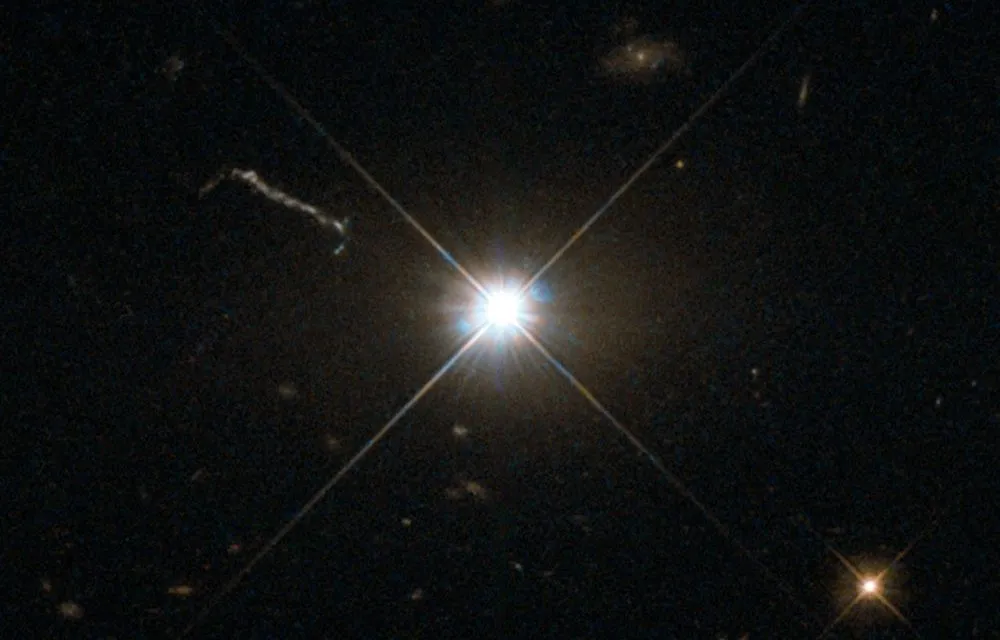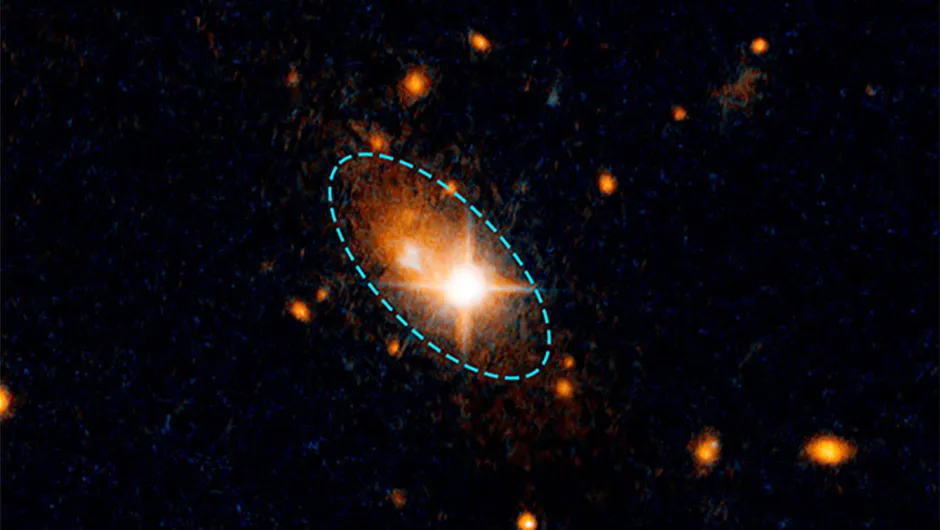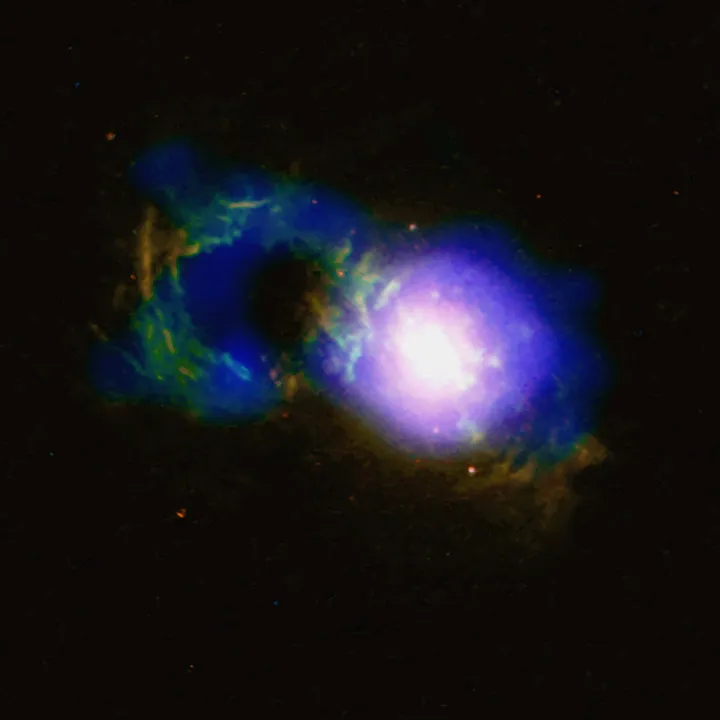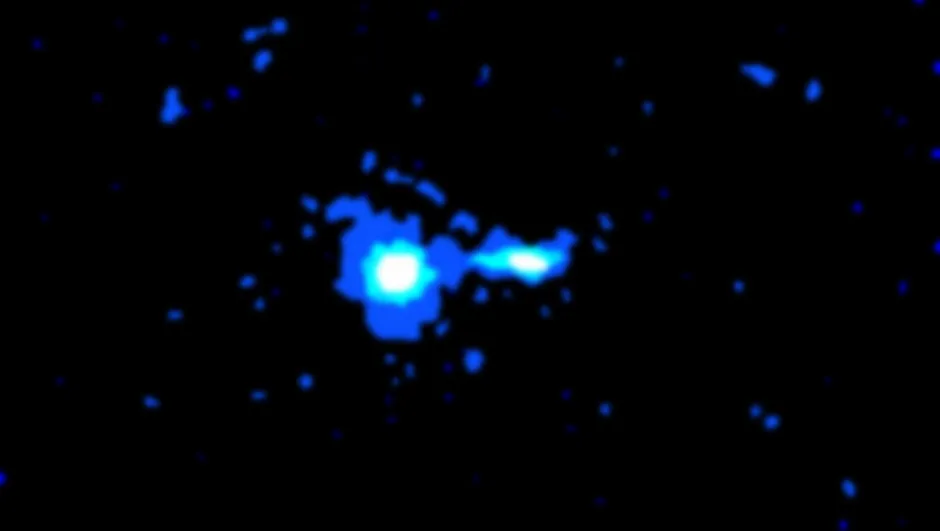When I began taking a real interest in astronomy, the types of objects in the sky seemed fairly straightforward.
We had the Sun and the planets of the Solar System, we had the stars which are suns, we had groups of stars, clusters of stars, nebulae and galaxies.
Today there are terms which were totally unknown in my younger days. No one had ever heard of things like pulsars, black holes or – quasars.

For a long time quasars were indeed mysterious; nobody knew just what they were. (They were known initially as ‘Quasi-stellar Objects’.)
They were found by radio astronomy – and even radio astronomy is comparatively new; it began in the 1930s, more or less by accident.
Now, of course, it is a vital part of astronomical research. In those early days there were radio telescopes that could pick up discrete radio sources in the sky, but could not define their positions very accurately.
Then, as time went by, radio telescopes were improved and could pick up very small radio sources.
It was known at an early stage that bright stars such as Canopus were not powerful radio sources; the strong emissions came from objects such as supernova remnants, notably the Crab Nebula.
Actually the first quasar to be identified is known as 3C 273, in Virgo (3C indicates the Third Cambridge Catalogue of radio sources, published in 1962.)

It was known to be a strong radio emitter but identifying 3C 273 with a visual object was very difficult.
Then, on 5 August 1962, radio astronomers in Australia working with the Parkes telescope followed an occultation of the radio source by the Moon, and were able to pinpoint its position very accurately.
It seemed to be identified with a faint bluish star, bright enough to be seen with a small telescope. But what was it?
In 1963, Maarten Schmidt at Palomar studied the spectrum of the object, and was totally baffled.
3C 273 was not a star at all, but something much more exciting.
There were spectral lines, but they did not seem to fit with known substances, and for some time the lines remained unidentified, but eventually the problem was solved.
The lines were due to hydrogen, highly redshifted. Now, this was significant.
According to the famous Doppler Effect, an object moving away from us will have all its spectral lines shifted to the red, and the greater the shift the greater the speed of the recession.
The object Schmidt was studying proved to be racing away from us at almost 48,000km/s, and to be over 2,000 million lightyears from us.
This was the first known quasar and it was followed by others; by now many hundreds are known.
Some of them are much further away than 3C 273 and are moving away at even greater speeds.
Their luminosities are immense. One quasar can outshine a complete galaxy.
For example, 3C 273 has about 2,000,000,000,000 times the luminosity of our Sun, or approximately 100 times the light of an average galaxy such as our Milky Way.
Not everybody accepted this picture. The theory championed by Fred Hoyle – the steady state theory – maintained that quasars were not nearly so far away or so powerful as generally believed.
Later, some astronomers went so far as to suggest that quasars are simply minor bodies ejected from galaxies.
But by now the steady state theory has been rejected by practically everybody, and we know that the interpretation of quasars as ultra-luminous and very remote is correct.

What makes quasars shine so brightly?
There are no quasars anywhere near us, which from our point of view is just as well.
Even when it was shown that they were so far away and so powerful, there was still the problem of finding out just what made them shine.
Again there were many suggestions, but it now seems quite definite that quasars are powered by supermassive black holes in their centres.
The escaping energy is actually generated outside what we call the event horizon, which is the boundary inside which nothing can escape from the black hole.
As material spirals inwards it is immensely heated, and gives off radiation of all kinds.
One notable property of quasars is they can show rapid changes in luminosity so that they must be small - no bigger than the orbit of Neptune round our Sun - because an object cannot change faster than the time it takes light to travel from one end of the object to the other.

It seems that quasars were much more common in the early Universe than they are now and it has even been suggested than many galaxies go through a quasar stage during their early lifetime.
This may or may not be true, but certainly there is no evidence that our Milky Way system has ever been a quasar in any form.
There are quasars of all kinds – even double quasars.
To cosmologists they are immensely valuable because they enable us to look back into the early stages of the Universe – and because they are so powerful they can be seen over vast distances.
Quite a number of quasars can be seen with small telescopes, and amateurs take pleasure in looking at them!
With an apparent magnitude of +12.8, 3C 273 is the brightest of them. Look at it with a telescope – it is in Virgo, and quite easy to find.
You may think it is an ordinary, innocent little star. But it is not a star and it is anything but innocent. Nobody can really appreciate its immense energy.
A black hole has to survive in that form by drawing in material from around it, and if there is no material upon which it can feed the black hole becomes inactive.
This must happen, and certainly the fact that there are no quasars anywhere near us is highly significant.

More to learn
Quasars proved to be a great surprise to astronomers; they are classed in the same category as active galactic nuclei, but they are of special importance.
Every discovery we make leads to a whole host of new problems, which we have to solve one by one.
It is now almost 50 years since quasars first became known to astronomers, and we have learnt a great deal about them since then.
Yet there is still a great deal that we do not know.
Research is going on at all our major observatories, but quasars guard their secrets well.
This article originally appeared in the March 2010 issue of BBC Sky at Night Magazine.

